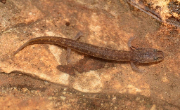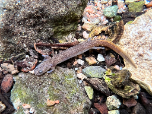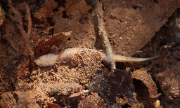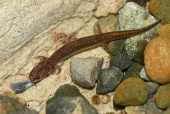Georgetown Salamander (Eurycea naufragia)
Description: Georgetown salamanders are small, permanently aquatic salamanders. Adults are typically 2.0–3.0 inches in length and less than 0.5 cm in diameter. Although their coloration varies, most adults are dark brown, dark olive, or gray. Juveniles tend to be darker in color. Coloration is confined to the dorsal and lateral sides of the body; the ventral surface is usually translucent. Many individuals have a light, cream- or yellow-colored stripe on the top of the tail.
The head is roughly shovel-shaped, broad but relatively short, and widest at the point where the upper and lower jaws meet. Three prominent external gills—often deep red in color—extend from each side of the head. The eyes are relatively large and have gold-colored irises. Black melanophores are concentrated around each eye, forming a black circle around the eye and a black line that runs from the corner of the eye to the nasal opening. There are 14-16 costal grooves, counting those in the fore limb and hind limb regions.
Habitat: Within the spring flows, the majority of salamanders are observed within a few meters of the spring origin.
Range: The Georgetown salamander is associated with wet caves and springs in the San Gabriel River watershed in Williamson County, Texas. Salamanders have been observed at 14 locations in the county. These locations include some historical records; ongoing studies are taking place at two of the locations. Within the spring flows, the majority of salamanders are observed within a few meters of the spring origin.
Found in these States:
TX
Diet: This salamander eats very small invertebrates in the stream water.
Reproduction: The Georgetown salamander is believed to reproduce in the winter, as many other Eurycea species do. The salamanders produce an estimated 30 to 50 eggs per clutch, but likely lay them individually. The hatchlings are about 1 cm long and grow rapidly until they reach a head-trunk length of about 3 cm. At this point, growth is slowed and some salamanders may even shrink a small amount. The juvenile stage is typically two months to three years. Similar species live for five to 15 years, though the exact lifespan of the Georgetown salamander is unknown.
Status: Listed as Critically Endangered because its extent of occurrence (EOO) is 65 km2, it is considered to occur in one threat-defined location, and there is continuing decline in the extent and quality of its habitat in Georgetown, Texas, USA.
»» Kingdom: Animalia - Animals
»» Phylum: Chordata - Chordates
»» Subphylum: Vertebrata - Vertebrates
»» Class: Amphibia - (Amphibians)
»» Order: Caudata - Salamanders
»» Family: Plethodontidae - Lungless Salamanders
»» Genus: Eurycea
»» Species: Eurycea naufragia - Georgetown Salamander
This article uses material from the Wikipedia article "Georgetown Salamander", which is released under the Creative Commons Attribution-Share-Alike License 3.0. Content may have been omitted from the original, but no content has been changed or extended.
|







